Parabolic SAR
The parabolic stop and reverse (SAR), also known as the stop and reversal system, is a technical indicator that can help spot the current trend direction, help with entering and exiting trades, and highlight potential reversals. Because it follows price movements, it can also be used as a trailing stop-loss. This allows the trader to capture large profitable trends when they occur, providing an exit point when the price may be starting to reverse.
What is parabolic SAR?
Parabolic SAR is a form of technical analysis that can be implemented for a comprehensive trading strategy, when analysing how to trade financial assets, such as indices, shares, commodities and currencies. In this article, we will discuss the pros and cons of the indicator, and look at how and when it should be used.
How is parabolic SAR calculated?
The parabolic SAR places dots above each price bar if the price is falling, and below each price bar if the price is rising. When the price passes through the dots, there is a potential trend reversal, and the dots move to the other side. In this way, its most basic function is to help spot the current trend and signal when that trend direction may be changing. The parabolic SAR indicator is complex to compute by hand, even though it was introduced in 1978 by J. Welles Wilder Jr. (who also developed the relative strength index), well before the widespread use of computers. The indicator is complex because it accelerates over time.
Parabolic SAR formula
The formulas used are different if the SAR is rising on an uptrend (below price) versus falling on a downtrend (above price).
Rising SAR = Prior SAR + Prior AF (Prior HP – Prior SAR)
Falling SAR = Prior SAR – Prior AF (Prior SAR – Prior LP)
AF stands for acceleration factor, which has a default of 0.02 and increases by 0.02 each time a new high price is achieved in the current trend. This has a maximum of 0.20.
HP stands for high point, which is the highest high in a current uptrend. Similarly, LP stands for low point, which is the lowest low in a current downtrend.
Thankfully, you will not need to calculate the parabolic SAR for each period, as our online trading platform, Next Generation, automatically calculates the parabolic SAR algorithm in just a few clicks when applied to a trading chart.
How to use the parabolic SAR indicator
The calculation shows that the further a trend moves in one direction, the faster the parabolic SAR will accelerate to catch up to it. This is beneficial in that the indicator provides room for the price to move higher (or lower), yet the further the price moves in one direction, the less room the indicator gives it, because a price reversal becomes more likely. Once the price drops below the parabolic SAR, the move may be complete, or at least entering a temporary pullback stage.
The parabolic SAR can be used in several ways in terms of strategies and can be applied to all financial markets. Its most basic functions are the following:
To find a buy point when the price moves above the dotted line, and the dots move below.
To find a sell or short point when the price moves below the dotted line, and the dots move above.
As a trailing stop loss. The parabolic SAR keeps you in a trade until a signal in the opposite direction occurs.
To indicate whether the price is recently rising or falling, and when a reversal may occur.
Combined with other rules and analysis, the parabolic SAR can form part of a robust trading strategy.
Parabolic SAR strategies
Parabolic SAR breakout
The parabolic SAR is an indicator that provides constant breakouts. Each time the parabolic SAR flips to the other side of the price, this could be considered a trend reversal or trend break. Therefore, one of the simplest breakout strategies is to wait for a parabolic SAR trade signal to enter in the trending direction following a pullback.
Let’s assume, for example, that the trend is up and the price is making overall upward progress. Once the parabolic SAR flips on top of the price, this means it is now moving down, entering a pullback. You could consider placing a stop-loss order below the swing low that formed prior to the entry signal in order to avoid losses.
Below is an example using an Apple stock chart. The price started rising, and the green boxes mark the start and end (and thus the profitability) of each trade that occurred during the uptrend. The current trade is ongoing, but already a small profit is locked in, since the trade will be exited if it drops below the indicator. Buy entries occur as the price moves above the dots in the overall uptrend.
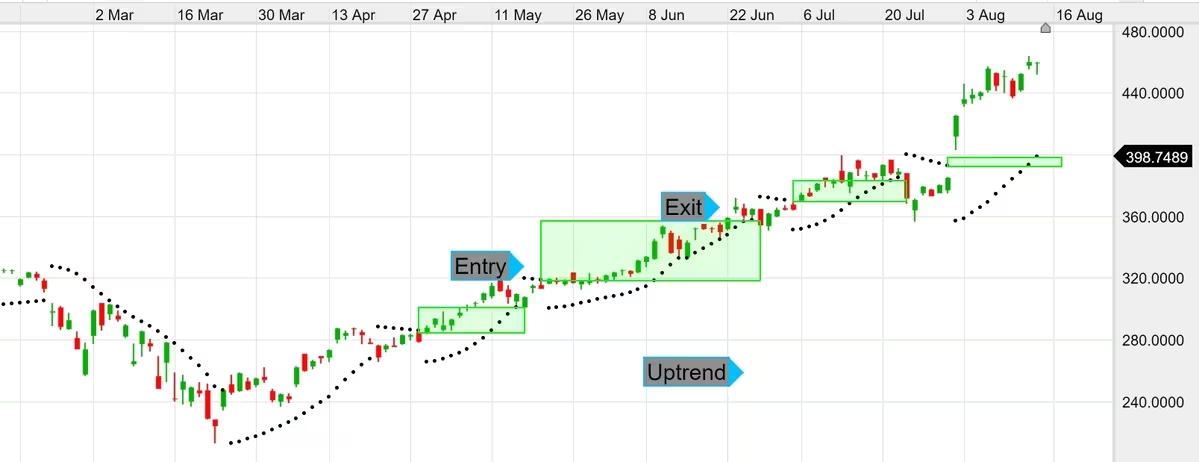
The concept is the same for a downtrend. When the price is declining, the parabolic SAR is above the price. When the parabolic SAR drops below the price, this indicates a pullback to the upside. A parabolic SAR breakout strategy works best in assets that are strongly trending. If the price is moving in no apparent direction, then it will seesaw across the parabolic SAR, resulting in multiple unprofitable trades. You should make sure you have the appropriate risk management measures in place.
Double parabolic SAR strategy
A double parabolic SAR strategy uses two timeframes. First, a longer-term timeframe shows the trend direction based on the direction of the parabolic SAR. Once the long-term trend direction is determined, trades are taken on a shorter timeframe, but only in the direction of the longer-term trend. For example, the daily chart of gold with a parabolic SAR attached shows that price is currently in an uptrend. The price is on top of the indicator as of 4 August.
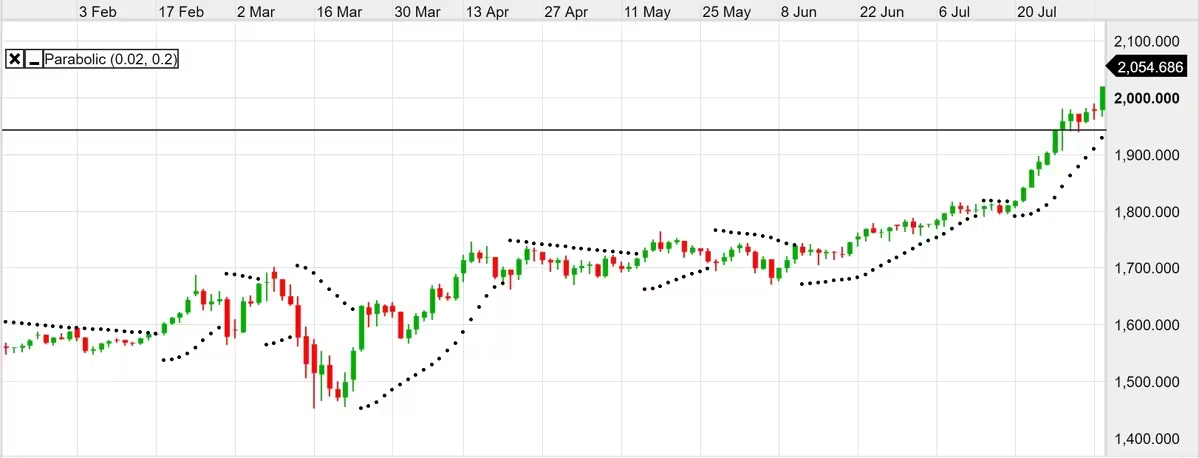
Then, when you drop down to the hourly chart (you can use any two timeframes, as long as one is longer than the other), and then only take new trade signals in the longer-term direction, the chart below shows the result.
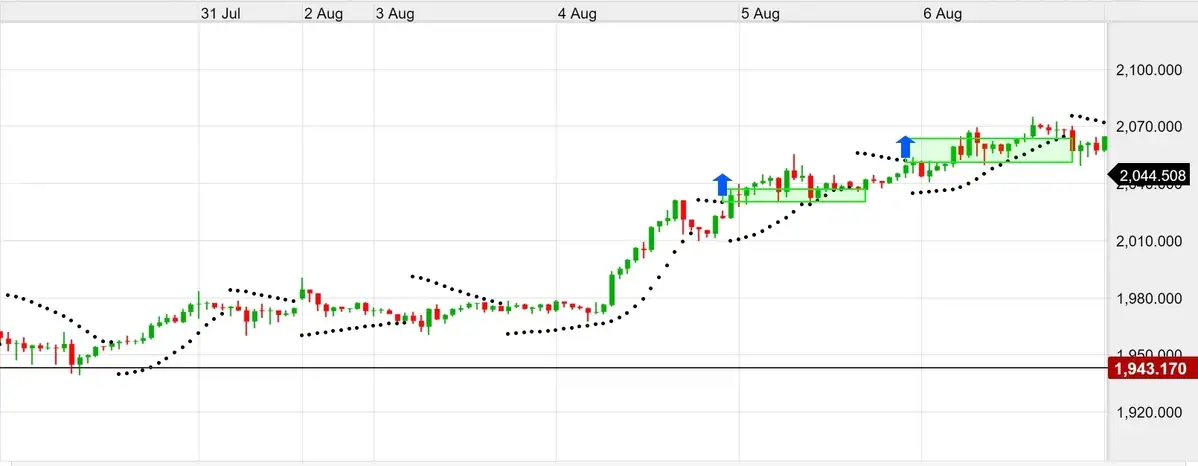
If the uptrend on the daily chart was spotted earlier, then additional trades could well have been made. Not all were profitable, but some were very profitable. The profitability of trades is the difference between the entry and exit, highlighted by the green boxes. This double parabolic SAR strategy is beneficial because it only takes trades in the direction of the longer-term trend, which are more powerful than short-term trends.
Parabolic SAR forex trading strategy
The parabolic SAR works the same in forex trading as it does in other markets, such as stocks or commodities. Any of the strategies discussed above can be applied to the forex market. As mentioned earlier, the indicator works best when there are large price movements. On the left side of the EUR/USD daily chart, the price action is choppy. The price whipsaws back and forth across the indicator, resulting in multiple losing or small-profit trades.
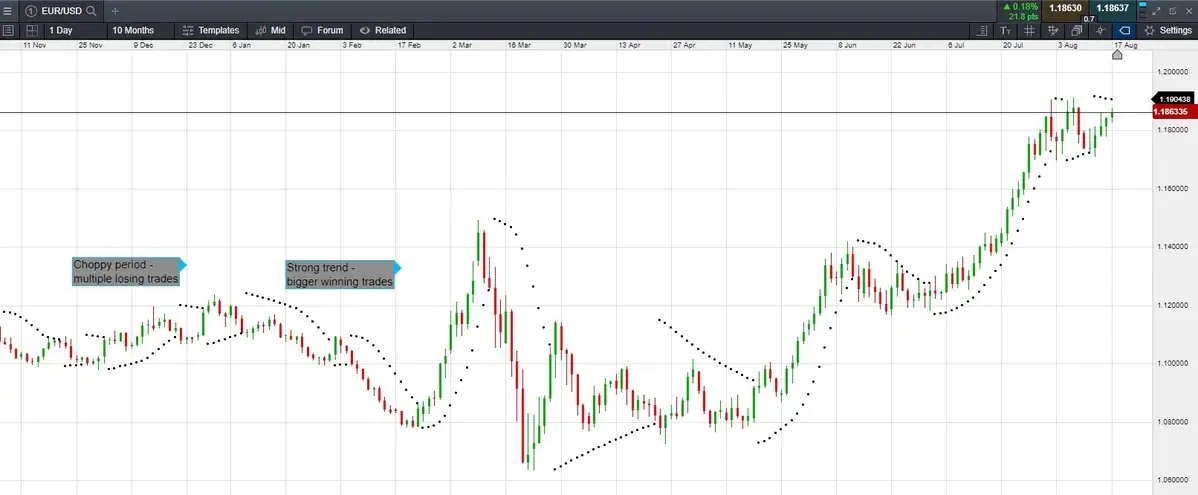
The much bigger profits come when there are big trending moves. A big move is any move that would have resulted in a substantial profit based on the parabolic SAR basic entry and exit trading signals.
Parabolic SAR scalping strategy
Scalping is a short-term trading strategy where the trader enters and exits trades as quickly as possible, opening multiple positions within a day. Scalpers often use a one-minute chart, and our online trading platform also allows you to trade with one, five, 10, and 30-second charts as well.
Any of the strategies discussed can be used for a scalping strategy. As an example, let’s use the double parabolic SAR strategy for a forex scalping trade. The longer timeframe is the 15 minute chart, and the lower timeframe is the one minute. From the 15-minute EUR/JPY chart, we can see that the trend is continually declining, based on the most recent parabolic SAR reading, for more than two hours.
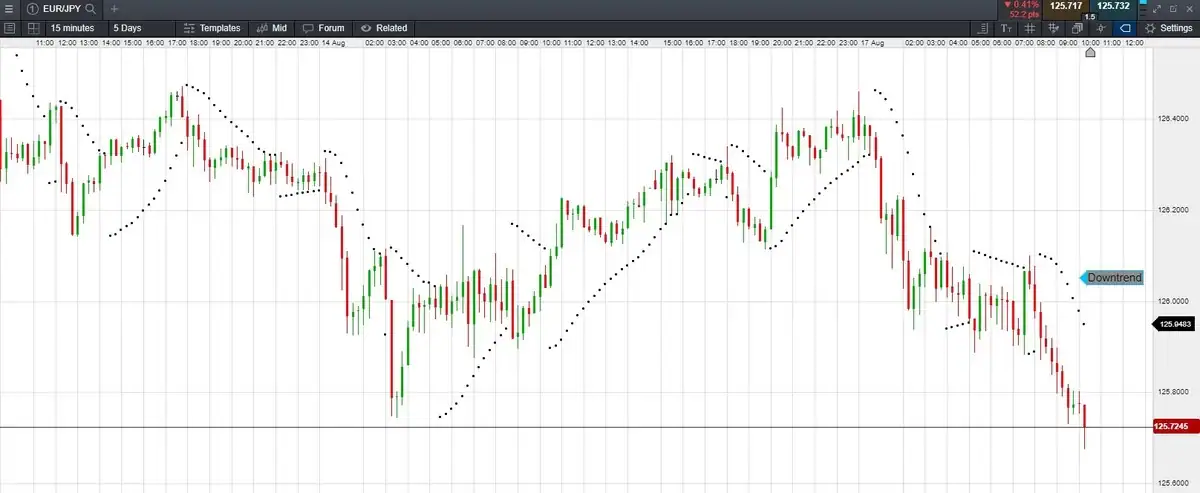
This provides the trade direction on the one-minute chart. Only short entries are taken when the price drops below the indicator. The short trades are exited when the price moves above the indicator.

If the uptrend on the daily chart was spotted earlier, then additional trades could well have been made. Not all were profitable, but some were very profitable. The profitability of trades is the difference between the entry and exit, highlighted by the green boxes. This double parabolic SAR strategy is beneficial because it only takes trades in the direction of the longer-term trend, which are more powerful than short-term trends.
How to use a parabolic SAR trading system
As mentioned, the parabolic SAR indicator is available on our Next Generation trading platform. To use the parabolic SAR and to start practising some of the strategies mentioned, register for a live account now. You can also register for a demo account to practise on our parabolic SAR trading system using virtual funds.
You can choose a financial product to trade along the left side of the platform, within the commodities, currencies, indices, shares, and treasuries markets. Its chart will appear on the right, and along the bottom of the chart, there is a tab for “Technical”. Scroll to the right until you see “Parabolic”. Click to apply it to the chart. The formula will be calculated automatically.
Parabolic SAR indicator settings
To change the technical indicator settings, hover your cursor over the chart and click on the indicator name in the upper left of the chart. This will bring up the parabolic SAR settings. Adjust as needed.
There are two setting on the indicator: Acceleration Factor (AF) and Maximum Acceleration (MA). By default, these are 0.02 and 0.2. Increasing the Acceleration Factor means the indicator will more closely track the price, leaving less room between the indicator and price. This means more trade signals and reversals will be identified on the chart. Decreasing the Acceleration Factor means that the indicator will move slower, leaving more room between the price and indicator. Fewer reversals will occur.
The Maximum Acceleration works the same in a way, but to a much lesser degree. The MA caps how quickly the indicator can accelerate during a strong price move. Changes in this setting will have less impact than changing the AF.
Short-term traders that want to enter and exit positions quickly may opt for a higher AF, which means that even small reversals will close them out of a trade. Longer-term traders that want to hold their positions may decrease the AF. This will result in the price needing to make bigger moves to cause a reversal, and thus reversals and trade signals will occur less often.
Parabolic SAR indicator on MT4
The parabolic SAR is also available for aiding trading strategies on the international platform, MetaTrader 4, which is hosted through our software. The indicator can be adjusted on MT4 in the same way as our own platform, but the names of the variables are different. On MT4, “Step” is the equivalent of the Acceleration Factor, which has a default setting of 0.02. Maximum is the Maximum Acceleration, and it has a similar default value of 0.2. Learn more about the platform by registering for a free MT4 account.
Parabolic SAR and stop losses
The parabolic SAR provides several basic functions that include providing trend direction, entry and exit signals, and acting as a trailing stop-loss. These basic functions can be further enhanced into a strategy by adding some additional rules. The breakout strategy requires isolating the overall visual trend direction. The double parabolic SAR strategy makes this approach more systemic by using the indicator direction on a longer-term timeframe as the overall trend direction. This stipulates in which direction to trade on the lower timeframe.
To complete all these strategies, the risk on each trade must be managed, and you should avoid taking a position size that is too large for your account. By using a stop-loss order, you can prevent capital loss if the price does not move in a favourable direction.
If you wait for a trade signal and candle or price bar to close before entering, then the dots will flip sides and that dot can be used as a stop loss point. However, sometimes the dot will be far away at the start of a trend, or you may not want to wait for a candle close before taking a trade signal. In these cases, you should consider placing a stop-loss below the recent swing low if going long, or above a recent swing high if going short. Two cents or two pips (percentages in point) above the swing or below the swing low is adequate. This final step makes sure that the risk is controlled, while the parabolic SAR takes care of locking in profit if the price moves favourably.
Disclaimer: CMC Markets is an execution-only service provider. The material (whether or not it states any opinions) is for general information purposes only, and does not take into account your personal circumstances or objectives. Nothing in this material is (or should be considered to be) financial, investment or other advice on which reliance should be placed. No opinion given in the material constitutes a recommendation by CMC Markets or the author that any particular investment, security, transaction or investment strategy is suitable for any specific person. The material has not been prepared in accordance with legal requirements designed to promote the independence of investment research. Although we are not specifically prevented from dealing before providing this material, we do not seek to take advantage of the material prior to its dissemination.
Disclaimer: CMC Markets is an execution-only service provider. The material (whether or not it states any opinions) is for general information purposes only, and does not take into account your personal circumstances or objectives. Nothing in this material is (or should be considered to be) financial, investment or other advice on which reliance should be placed. No opinion given in the material constitutes a recommendation by CMC Markets or the author that any particular investment, security, transaction or investment strategy is suitable for any specific person. The material has not been prepared in accordance with legal requirements designed to promote the independence of investment research. Although we are not specifically prevented from dealing before providing this material, we do not seek to take advantage of the material prior to its dissemination.

